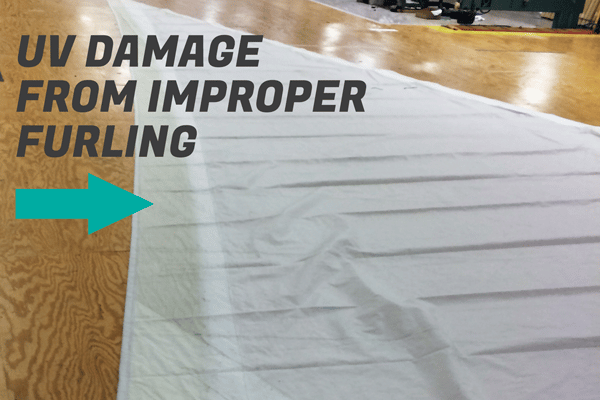
1. Mildew, mold, and runny colors
Letting your wet sails stay furled or flaked in a sail bag creates the perfect incubator for mold and mildew to grow. All sail cloth types, when stored wet, will promote the growth of mildew, but it’s really a problem with less breathable laminated sails. Keep in mind, where you store them is also important. Damp locations also attract mold and mildew. Regardless of how it gets there, once you have mold, your sail needs a professional cleaning.
Your spinnaker needs to dry too. Nylon, when left wet, has the tendency for the colors to run together. Once that happens, we can apply a special coating to help stabilize the colors, but it can be expensive.
The simple solution: You guessed it, make sure your sails are completely dry before storing them. If you don’t always have that luxury, look into getting an anti-fungicide coating to help protect the fabric. If you’re storing your sails for an extended period of time, click here to read our tips on how to store your sails correctly.
2. Your boat tips/heels too much
Ok, this isn’t exactly a sail disaster, but if you’re not careful, it can become one. A frequent complaint is that a boat heels too much, or even tips over, in heavy air. Though there could be some outlying factors, one thing to consider is the shape of your sail. A sail’s shape changes over time with use as the fibers stretch out and wear with time. Those changes can cause the boat to heel more than it should.
The simple solution: If you feel that you’re heeling too much or are in danger of tipping over, take a few pictures when you’re using your sails upwind and take them to your local loft. The service department can then identify where your sail’s geometry has changed, then modify it to take it back to its original design shape – that will keep you moving forward instead of tipping over and causing serious damage. It can also buy you a few more years before having to replace the sail.
3. Your roller furled sail is brittle and cracking
Your sail is probably rolled on the furler the wrong way. Sun exposure shortens the life of any fabric, and sails are no different. A roller furler that lives on the headstay should have a piece of sacrificial fabric sewn onto the side that’s exposed to the sun. When rolled correctly, that piece of fabric absorbs the UV damage while your sail fabric stays protected.
When people aren’t familiar with how a roller furler works, or if the UV cover is white like the sail, it can be difficult to tell from the cockpit if the sail is rolling the right way. When it doesn’t, your sail is left exposed to the elements.
The simple solution: If you’re not sure if your sail is rolled the correct way or have any questions, call your sails consultant or the local service department. Taking some time to meet at your boat to make sure the sail is rolling properly and is protected from the elements can save you $500-1,500 in repairs later.
4. Your UV cover is peeling off the sail
The same way your sail cover is exposed to UV damage, so is the stitching that holds it in place. UV rays weaken the thread over time, eventually to the point of failure. If you’re lucky, you’ll notice frayed threads before the cover begins to peel off the sail – if not, your cover could come off while sailing!
The simple solution: Annual inspections are key, but it’s equally important to inspect your own sail on a regular basis, looking for things like small tears and frayed threads. Some people say you can go 2-7 years before you need to have your sail checked, but if your boat’s in the sun a lot, it’s best to take your sails in for an annual tune-up. Your Quantum service department will spot weak areas before they become a problem, saving you time and money on your repairs.
Again, just like your car needs regular maintenance and tune-ups, so do your sails. Don’t wait for disaster to strike. Combined with proper sail care, regular inspections by expert service staff will help prevent large problems and ensure you get the most out of your sails.
This cruising tip has been brought to you by Quantum Sails








